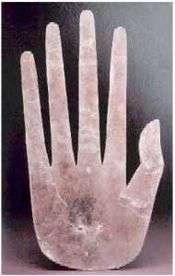Elsie Allen
| Elsie Allen | |
|---|---|
| Born |
Elsie Comanche Allen September 22, 1899 California |
| Died |
December 31, 1990 (aged 91) California |
| Nationality | Pomo |
| Education | Self-taught |
| Known for | Basket weaving |
Elsie Allen (22 September 1899 – 31 December 1990) was a Native American Pomo basket weaver from the Cloverdale Rancheria of Pomo Indians of California in Northern California, significant as for historically categorizing and teaching Californian Indian basket patterns and techniques and sustaining traditional Pomo basketry as an art form.
Background
Elsie Comanche Allen was born on 22 September 1899 near Santa Rosa, California. [1] Her parents, George and Annie Comanche (Comanche is an Anglicized version of the Pomo name, Gomachu), were farm laborers. Her father died when she was eight. Soon after, her mother remarried and moved the family to Hopland. Elsie's first language was Pomo.[2] This was the only language she spoke until she was 13, when she began learning English at school near Hopland. In addition to Hopland, Elsie lived in several Pomo communities, including Cloverdale and Pinoleville Rancherias.
Elsie married Arthur Allen, a northern Pomo, in 1919. Together the couple had four children, Genevieve, Leonard, Dorothy, and George.[2]
Basketry
Elsie came from a family of accomplished basketweavers, including her mother, Annie Ramon Gomachu Burke (1876–1962) and her maternal grandmother, Mary Arnold (1845–1925), both of Cloverdale Rancheria.[3] Elsie's mother, Annie founded the Pomo Indian Women's Club, which promotes the tribe's basketry. She also convinced Elsie to break with tradition and not burn or bury her baskets – instead to keep them for future basketmakers.[3]
Although she learned to weave as a child, Allen was only able to weave full-time at the age of 62, when her children were all grown. During the 1950s and 1960s, interest in basketry among Pomo had waned, so Allen began teaching anyone interested in learning her technique, which created controversy in her tribe.[3] She taught at the Mendocino Art Center.[2] Late in her career, Elsie Allen began using commercial materials in her baskets after receiving a vision.[4] One of her last students was her niece, Susan Billy.[5]
Southern Pomo language
Allen worked with linguist Abraham M. Halpern to document the Southern Pomo language.[6]
Legacy
Allen died on December 31st, 1990.[2]
Together with Mabel McKay, Laura Somersal, Elsie Allen is regarded as one of the three best known California basketweavers of her generation.[7] Allen is the subject of several books, including Dot Brovarney, Susan Billy, and Suzanne Abel-Vidor's 2005 Remember Your Relations: Elsie Allen Baskets, Family, And Friends and Sandra J. Metzler's 1996 A promise kept: Basketry of the Pomo and the Elsie Allen basket collection.[8]
Elsie Allen High School in Santa Rosa, California is named for her.[2]
Published work
- Allen, Elsie. Pomo Basketmaking: A Supreme Art for the Weaver. Red. ed. Happy Camp, California: Naturegraph Publishers, Inc. 1972.[9]
See also
Notes
- ↑ "Elsie Allen, 1899-1990". Sonoma State University Libraary. Retrieved 7 April 2016.
- 1 2 3 4 5 Elsie Allen 1899-1990. Sonoma State University Library. 18 Sept 2007 (retrieved 22 April 2009)
- 1 2 3 Wyckoff, 64
- ↑ Dalrymple, 2
- ↑ Wyckoff, 65
- ↑ "UC Berkeley, BLC Audio Archive of Linguistic Fieldwork: Southern Pomo Recordings". mip.berkeley.edu. Retrieved 13 May 2010.
- ↑ Dalrumple, 2
- ↑ Amazon.com. (retrieved 22 April 2009)
- ↑ Wyckloff, 233
References
- Dalrymple, Larry. Indian Basketmakers of California and the Great Basin. Santa Fe: Museum of New Mexico Press, 2000. ISBN 0-89013-337-9.
- Wycliffe, Lydia L. Woven Worlds: Basketry from the Clark Field Collection at the Philbrook Museum of Art. Tulsa, OK: Philbrook Museum of Art, 2001. ISBN 0-86659-024-2.
External links
- Elsie Allen Exhibit at the Oakland Museum of California
- Elsie Allen. Native American Indian Art
- Elsie Allen (1899-1990) Pomo Basket Family
